Abstract
This paper details the design, construction, and performance analysis of a biologically inspired knee joint for use in bipedal robotics. The design copies the condylar surfaces of the distal end of the femur and utilizes the same crossed four-bar linkage design the human knee uses. The joint includes a changing center of rotation, a screw-home mechanism, and patella; these are characteristics of the knee that are desirable to copy for bipedal robotics. The design was calculated to have an average sliding to rolling ratio of 0.079, a maximum moment arm of 2.7 in and a range of motion of 151°. This should reduce wear and perform similar to the human knee. Prototypes of the joint have been created to test these predicted properties.
Access this chapter
Tax calculation will be finalised at checkout
Purchases are for personal use only
Similar content being viewed by others
References
Mukras, S., Kim, N.H., Mauntler, N.A., Schmitz, T.L., Sawyer, W.G.: Analysis of planar multibody systems with revolute joint wear. Wear 268, 643–652 (2010)
Asano, Y., et al.: Achievement of twist squat by musculoskeletal humanoid with screw-home mechanism. In: IEEE RSJ International Conference on Intelligent Robots and Systems (2013)
Etoundi, A.C.: A bio-inspired condylar hinge joint for mobile robots. In: International Conference on Intelligent Robots and Systems (2011)
Burgess, S.C., Etoundi, A.C.: Performance maps for a bio-inspired robotic condylar hinge joint. J. Mech. Des. 136, 115002–115007 (2014)
Khan, H., Featherstone, R., Caldwell, D.G., Semini, C.: Bio-inspired knee joint mechanism for a hydraulic quadruped robot. In: 2015 6th International Conference on Automation, Robotics and Applications (ICARA), pp. 325–331 (2015)
Etoundi, A., Burgess, S., Vaidyanathan, R.: A bio-inspired condylar hinge for robotic limbs. J. Mech. Robot. 5, 8 (2013)
Steele, A.G., Hunt, A., Etoundi, A.C.: Development of a bio-inspired knee joint mechanism for a bipedal robot. In: Mangan, M., Cutkosky, M., Mura, A., Verschure, Paul F.M.J., Prescott, T., Lepora, N. (eds.) Living Machines 2017. LNCS (LNAI), vol. 10384, pp. 418–427. Springer, Cham (2017). https://doi.org/10.1007/978-3-319-63537-8_35
Masouros, S.D., Bull, A.M.J., Amis, A.A.: Biomechanics of the knee joint. Orthop. TRAUMA. 24, 84–91 (2010)
Hobon, M., Elyaaqoubi, N.L., Abba, G.: Quasi optimal sagittal gait of a biped robot with a new structure of knee joint. Robot. Auton. Syst. 62, 436–445 (2014)
Soucie, J.M., et al.: Range of motion measurements: reference values and a database for comparison studies. Haemophilia 17, 500–507 (2011)
Fox, A.S.J., Wanivenhaus, F., Rodeo, S.A.: The basic science of the patella: structure, composition, and function. J. Knee Surg. 25, 127–141 (2012)
Halonen, K.S., et al.: Importance of patella, quadriceps forces, and depthwise cartilage structure on knee joint motion and cartilage response during gait. J. Biomech. Eng. 138, 071002 (2016)
Abulhasan, J.F., Grey, M.J.: Anatomy and physiology of knee stability. J. Funct. Morphol. Kinesiol. 2, 34 (2017)
Fekete, G., et al.: Sliding-rolling ratio during deep squat with regard to different knee prostheses. Acta Polytech. Hung. 9, 20 (2012)
Fekete, G.: Kinetics and kinematics of the human knee joint under standard and non-standard squat movement (2013)
Acknowledgments
The authors acknowledge the support of the Mechanical and Materials Engineering Department in the Maseeh College of Engineering at Portland State University and the support of the UK Engineering and Physical Sciences Research Council (EPSRC) under grant reference EP/P022588/1.
Author information
Authors and Affiliations
Corresponding author
Editor information
Editors and Affiliations
Rights and permissions
Copyright information
© 2018 Springer International Publishing AG, part of Springer Nature
About this paper
Cite this paper
Steele, A.G., Hunt, A., Etoundi, A.C. (2018). Biomimetic Knee Design to Improve Joint Torque and Life for Bipedal Robotics. In: Giuliani, M., Assaf, T., Giannaccini, M. (eds) Towards Autonomous Robotic Systems. TAROS 2018. Lecture Notes in Computer Science(), vol 10965. Springer, Cham. https://doi.org/10.1007/978-3-319-96728-8_8
Download citation
DOI: https://doi.org/10.1007/978-3-319-96728-8_8
Published:
Publisher Name: Springer, Cham
Print ISBN: 978-3-319-96727-1
Online ISBN: 978-3-319-96728-8
eBook Packages: Computer ScienceComputer Science (R0)




